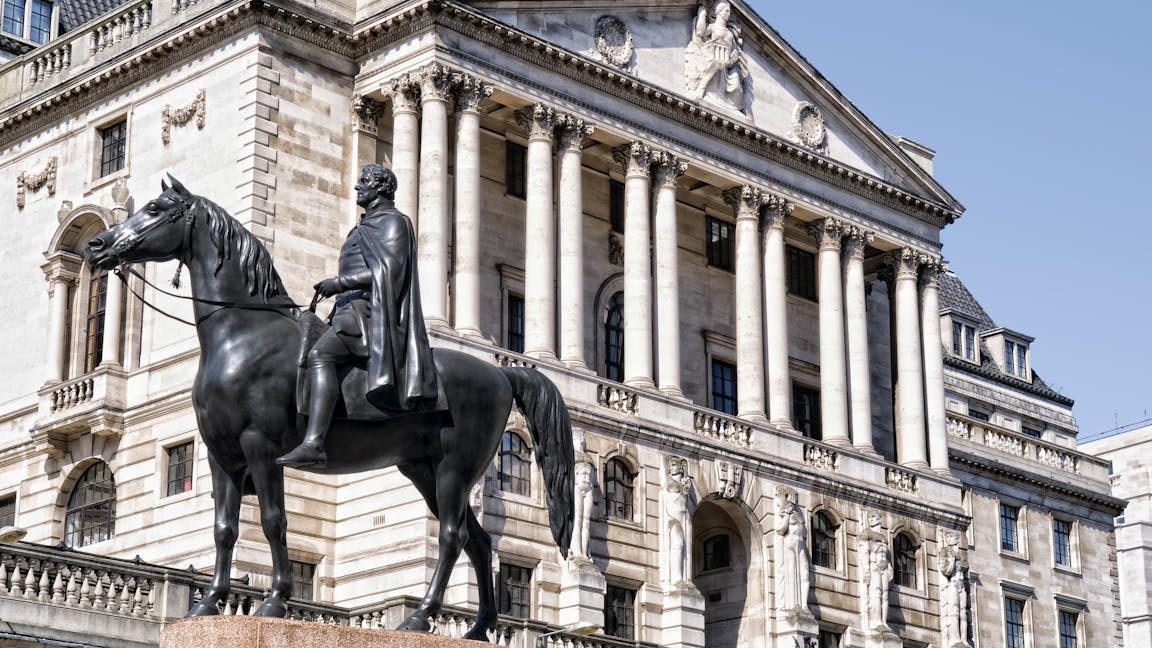
As expected, the Bank of England kept the key policy rate unchanged at 4% at its September meeting. Our experts explain why policymakers are in such a tricky position.
The Bank of England (BoE) was not expected to cut rates at today's September meeting. In fact, markets do not fully expect the next rate cut until April 2026.
That doesn’t mean they don’t want to. BoE communication makes it clear rates would ideally be lower, but policymakers at the central bank are in a tight spot.
The principal policy makers at the BoE, the Monetary Policy Committee (MPC, ‘the Committee’), have cut rates five times from a high of 5.25% in July 2024.
At 4%, the base rate is still some way above ‘neutral’. The neutral rate is the level at which the Bank of England believes the base rate will keep inflation low and stable, while giving the economy room to grow. We estimate the neutral rate to be around 3%.
So why can't the BoE just lower rates?
The sticking point is inflation.
Core inflation has remained stuck between 3%-4% all year, with August's reading (released on Wednesday) coming in at 3.6%. And it’s services prices that are the main driver, up 4.7% versus a year ago, albeit showing some signs of modest deceleration. Wages are the chief culprit. Wage data released this week for the month of July show regular earnings growing at 4.8% (excluding bonuses).
That’s way above ~2% BoE inflation target, and means core inflation is sticking at around 3.5%
At the last BoE meeting, in August, four members of the MPC voted against the 25 basis point cut that was delivered. Among them was the BoE's Chief Economist Huw Pill. At the start of the rate cutting process, the BoE said they would cut once a quarter to slowly and carefully get rates back towards neutral. Even though the bank rate was ultimately cut, passing on a 5-4 vote, comments from the MPC on the day were cautious. In the BoE's own words:
"Pay growth remains elevated, but has declined further recently, and is still expected to slow significantly over the rest of the year. Services consumer price inflation has been broadly flat over recent months. The Committee continues to be vigilant about the extent to which easing pay pressures will feed through to consumer price inflation."
It seems the abstainers to rate cuts wish to see more progress on cooling wage growth before continuing the journey to neutral rates.
The BoE readily acknowledges that policy is still tight. As it should be, with the current core CPI and wage pressures elevated as they are. The summary of the September MPC meeting left the below passage unchanged.
"A gradual and careful approach to the further withdrawal of monetary policy restraint remains appropriate. The restrictiveness of monetary policy has fallen as Bank Rate has been reduced. The timing and pace of future reductions in the restrictiveness of policy will depend on the extent to which underlying disinflationary pressures continue to ease. Monetary policy is not on a pre-set path, and the Committee will remain responsive to the accumulation of evidence."
Note the two uses of the word ‘restrictive’.
Between a rock and a hard place
If the decision were based only on inflation, it might be simple. But there is a reason the government – and by extension the BoE – would be keen to see policy rates cut more quickly.
To make sense of that, we need to rewind a bit first.
The support offered by the Bank of England in response to the global financial crisis - through so-called ‘quantitative easing’ (QE) – was so extensive that its legacy lasts to this day. That process involved buying bonds (mostly government bonds) to keep the market functioning and the UK economy moving. Through QE, the BoE took on a huge number of bonds from big financial firms in exchange for reserves at the BoE. These reserves attract interest, paid by Treasury (the government), to the financial firms.
In 2022, the BoE began to unwind this process. It is called quantitative tightening (QT), and involves a combination of
- Allowing bonds bought during the ‘QE’ phase to mature
- Actively selling bonds, to reduce the size of its balance sheet (and reducing the interest bill for the reserves mentioned above).
The stubborn inflation backdrop means that bond prices have fallen, the upshot of which is that the Bank has slowed down its QT activity. The pace of QT is slowing from around £100 billion per year to about £70 billion per year, and focused more on shorter and medium-term gilts.
The fear is that if they continue QT at the existing rate, that selling pressure will lead bond prices to fall further, and add more to losses on the BoE bond holdings. The Treasury has to cover these losses, so falling prices would be an adverse budgetary outcome and reduce the budgetary flexibility the government has to pursue economically supportive policies.
The sheer number of moving parts involved in setting monetary policy means that the Bank of England has a lot to consider with its policy decisions at the moment.
Risk warning
As with all investing, your capital is at risk. The value of your portfolio with Nutmeg can go down as well as up and you may get back less than you invest. Past performance and forecasts are not reliable indicators of future performance. We do not provide investment advice in this article. Always do your own research.
